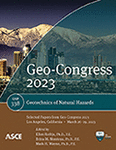Erosion Potential of Frost-Susceptible Soils Subjected to Freeze-Thaw Cycles
Publication: Geo-Congress 2023
ABSTRACT
This paper presents the results of a series of laboratory experiments performed to evaluate the erosion potential of silt and clay deposits that were subjected to repeated freeze-thaw cycles. The effects of climate change are more pronounced with several soil erosion, slope failures, and other mass-wasting event sites. To evaluate the erosion potential with cyclic freezing and thawing, soils from different geological formations with dominant silt and clay fractions were collected. Basic characterization of soils including unified soil classification system (USCS) classification, Atterberg limits, Proctor tests, and mineralogy were determined. The samples were prepared with three different moisture contents’ optimum moisture content (OMC) and ±5% OMC. Samples were subjected to freeze-thaw (F-T) patterns using a custom-built device that facilitates top-down freezing similar to in situ conditions. After 0, 1, 2, 10, and 20 F-T cycles, samples were tested for erosion potential using a modified erosion function apparatus for different flow conditions and molded moisture content. The coefficient of soil erosion, sediment loss, and volume of eroded soil was determined for the samples after each cycle. Test results and analyses depicted that the erosion potential of these soils significantly increased with an initial increase in F-T cycles. This paper highlights the vulnerability of the soils to erosion after thawing.
Get full access to this article
View all available purchase options and get full access to this chapter.
REFERENCES
Benton, R., Interior, S., and Stetler, L. D. (2014). Determining Erosion Rates at Select Fossil Sites to Develop a Paleontological Monitoring Program.
Bheemasetti, T., Tabassum, T., Lingwall, B., and Rahman, R. (2021). Evaluating Erosion Potential of Stabilized Fine-Grained Soils. 10th International Conference on Soil Erosion and Scour.
Briaud, J.-L., Chen, H.-C., Govindasamy, A. V., and Storesund, R. (2008). Levee Erosion by Overtopping in New Orleans during the Katrina Hurricane. Journal of geotechnical and geoenvironmental engineering, 134(5), 618–632. https://doi.org/doi:10.1061/(ASCE)1090-0241(2008)134:5(618).
Briaud, J. L., Ting, F. C. K., Chen, H. C., Cao, Y., Han, S. W., and Kwak, K. W. (2001). Erosion Function Apparatus for Scour Rate Predictions. Journal of geotechnical and geoenvironmental engineering, 127(2), 105–113. https://doi.org/doi:10.1061/(ASCE)1090-0241(2001)127:2(105).
Evanoff, E., Terry, D., Benton, R., Minkler, H., Terry, M., Duke, E., and Tielke, J. (2010). Field guide to geology of the White River Group in the North Unit of Badlands National Park. South Dakota School of Mines and Technology Bulletin, 21, 96–127.
Fehrenbacher, J., White, J., Ulrich, H., and Odell, R. (1965). Loess distribution in southeastern Illinois and southwestern Indiana. Soil Science Society of America Journal, 29(5), 566–572.
Grimley, D. A., Follmer, L. R., Hughes, R. E., and Solheid, P. A. (2003). Modern, Sangamon and Yarmouth soil development in loess of unglaciated southwestern Illinois. Quaternary Science Reviews, 22(2-4), 225–244.
Jacobs, P. M., Knox, J. C., and Mason, J. A. (1997). Preservation and recognition of middle and early Pleistocene loess in the Driftless Area, Wisconsin. Quaternary Research, 47(2), 147–154.
Larson, E. E., Evanoff, E., Terry, D., LaGarry, H., and Hunt, R. (1998). Tephrostratigraphy and source of the tuffs of the White River sequence., 1-14.
Léonard, J., and Richard, G. (2004). Estimation of runoff critical shear stress for soil erosion from soil shear strength. Catena, 57(3), 233–249. https://doi.org/https://doi.org/10.1016/j.catena.2003.11.007.
Mason, J., Joeckel, R., and Bettis, E., III. (2007). Middle to Late Pleistocene loess record in eastern Nebraska, USA, and implications for the unique nature of Oxygen Isotope Stage 2. Quaternary Science Reviews, 26(5-6), 773–792.
Simpson, H. E. (1960). Geology of the Yankton area, South Dakota and Nebraska (2330–7102).
Stetler, L. D. (2018). Impacts of Material Engineering Properties on Slope Wash and Stability in Fine-Grained Bedrock Slopes at Fossil-Bearing Sites, Badlands National Park, South Dakota, USA. Geosciences, 8(7), 267.
Tabassum, T. (2021). Post-fire erosion potential of clayey sand soils and slopes – A laboratory study. 10th International Conference on Soil Erosion and Scour.
Terry, D. O., LaGarry, H. E., and Hunt, R. M. (1998). Depositional environments, lithostratigraphy, and biostratigraphy of the White River and Arikaree Groups (late Eocene to early Miocene, North America) (Vol. 325). Geological Society of America.
Information & Authors
Information
Published In
History
Published online: Mar 23, 2023
ASCE Technical Topics:
Authors
Metrics & Citations
Metrics
Citations
Download citation
If you have the appropriate software installed, you can download article citation data to the citation manager of your choice. Simply select your manager software from the list below and click Download.
